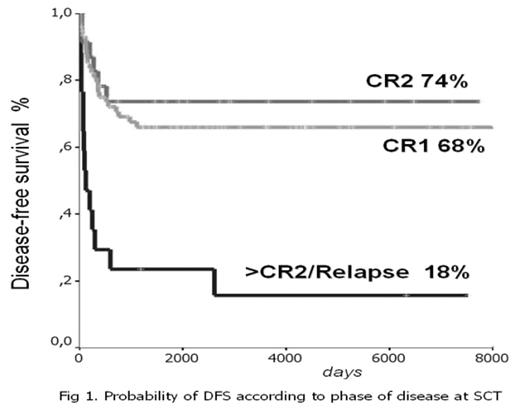Abstract
In this study we report the results of SCT in 116 patients (M51, F65) with AML transplanted from HLA identical (n=111) or 1 antigen mismatched (n=5) related donors between 1981 and 2006. The median age was 33 years (1–63). At time of SCT, 76 patients were in CR1, 23 in CR2 and 17 in CR>2 or in relapse. The stem cell source was bone marrow for 94 patients, PBSC for 21 and cord blood for 1. The conditioning regimen was myeloablative for 110 patients (BU CY for 87 and TBI CY for 23) and not-myeloablative for 6 (Thiotepa CY). For GvHD prophylaxis, 30 patients received cyclosporine (CSA) alone and 86 were given CSA and short course methotrexate. All patients engrafted with a median time to achieve 0.5 ×109/L neutrophils and 50×109/L platelets of 20 (10–37) and 22 (11–103) days respectively. One patients lost the graft six months after SCT and was successfully retransplanted. Acute GvHD grade II–IV occurred in 24%. Chronic GvHD occurred in 21% (9% limited, 12% extensive). The overall transplant related mortality (TRM) was 15.5% at 12 months (14,4% in CR1, 8,7% in CR2 and 29% in CR>2 or in relapse). Causes of death were: GvHD in 6 patients, infection in 6, multiorgan failure in 3, renal insufficiency in 1, encephalopathy in 1, pancreatitis in 1. The overall incidence of relapse was 29% (25% in CR1, 26% in CR2, 53% in CR>2). Twelve patients (1 in CR1, 5 in CR2 and 6 in >CR2 or relapse) underwent a second SCT from the same donor after a median interval from the first and second SCT of 456 (203–1946) days. The TRM post-second SCT was 16%. Nine of 12 patients are now living and cured after a median follow-up of 5,4 years (1–16,8). Overall, after a median follow-up of 8.08 (0.3–22) years, 71 out of 116 patients (61%) are living and cured. The 20 years probability of disease free survival is 68% for patients in CR1, 74% for patients in CR2 and 18% for patients in CR>2 or relapse (Fig. 1). In univariate analysis the patient age < 30 years, the BUCY regimen as compared to the TBI regimen and a dose of marrow cells > 3.0 × 108/Kg are associated with a better survival. We conclude that SCT is a curative treatment for patients with AML. In our experience second SCT gives results comparable to those of first transplant.
Probability of DFS according to phase of disease at SCT
Disclosure: No relevant conflicts of interest to declare.
Author notes
Corresponding author


This feature is available to Subscribers Only
Sign In or Create an Account Close Modal